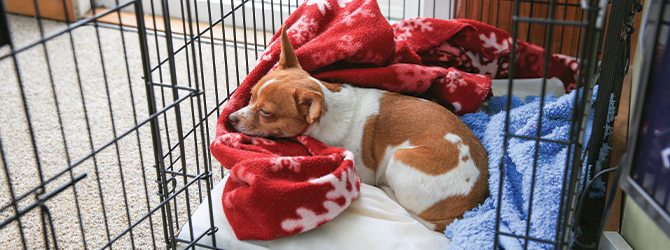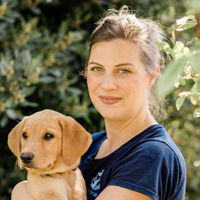How to crate train a dog: a guide to puppy cage training
Crates are great! When used correctly, they can help with toilet training, provide your puppy with a lifelong safe haven and ensure that your furniture or carpets aren’t spoilt while you’re asleep.
The trick is, of course, to make sure that you’re using your puppy’s crate correctly – doing otherwise can have a negative impact on your furry friend.
Let’s take a closer look at puppy cage training, and how to get your new pet feeling safe and comfortable in their new space.
Choosing the right crate
If you thought crate training only begins when you first bring your dog home – you thought wrong.
Before bringing your new friend home, you’ll need to identify the correct crate for them. The crate needs to be an appropriate size: roomy enough so your pup is able to stand up, sit down, turn around and stretch out fully - ideally with a bed area and a non-bed area so the pup can lie off the bed if they get hot.
Add to your crate a comfy bed, a food bowl, water bowl and plenty of toys. It’s also worth investing in a blanket so you can cover the crate and give your pup some privacy – although while training, it’ll be a massive help if they’re able to see you.
It’s also a good idea to set up the crate, ready for when your new pet comes home. This way, they’ll think of it as an established part of their new home environment.
Introduce the crate as something positive
Aim to begin cage training as soon as your new puppy comes home.
Use treats to help your puppy think positively about their crate. Start by placing their treats by the door and as your puppy grows more used to popping in to retrieve the treat, place it further and further in. Once they’re comfortable wandering in and out of their crate, you can start closing the door. Try to scatter food in the crate when your pup isn’t looking, this way they’ll discover good stuff in their crate whenever they choose to explore it on their own.
When you do close the door, stay where you are so your pup doesn’t feel abandoned or scared. Open the door, reach in and drop a treat on their bed and close the door again. Repeating this will familiarise them with the sound of the door shutting, as well as with spending time in their cage generally.
Don’t force the process
If your pup wants to come out at any time, let them – don’t ever close the door in their face or force them to stay in. The crate won’t feel safe if they’re forced into it against their will. It’s a good idea to commence this training when your pup is tired and likely to settle for a nap.
It’s not all about treats! When you’re playing with your pup, try to place their toys in the crate. This way, they’ll associate it not only with tasty treats, but as part of their play time too.
Your puppy should choose to use their crate voluntarily when given the choice. If they never choose to use it, more training is likely to be needed.
Close the crate for short periods of time – and increase them gradually
Puppy cage training is a gradual process. A dog shouldn’t associate their crate negatively, so avoid using crate or cage time as punishment.
Once your pup is comfortable with the door being shut, sit with them until they settle down. Try not to interact with them too much, but stay where they can see you for the first few sessions. Build up the time your pup is settled into their crate gradually, staying near enough so you can hear any distress or vocalisation. You can then progress to keeping your pup in their crate for longer periods – such as when nipping out to the shops (video them if you want to check how settled they are).
Stuffed Kong toys can really help a puppy to feel comfortable in their new crate. The same goes for normal food and fresh, clean water.
Crying, whining or scratching
Never leave a puppy (or adult dog) alone in their crate if they’re crying or scratching at the door. This behaviour means that they’re experiencing a negative emotional state, and will come to associate this with being in their crate.
Respond to this behaviour by taking the minimum necessary action to calm them – returning to the room so your puppy can see you might be sufficient, or sitting right next to the crate and talking to them.
Open the door once your pup is quiet and calm. Your training may have moved too fast, so go back a few stages.
Crate training a puppy at night
When it comes to prolonged periods, such as night time or your work day, you’ll need to make some compromises as the owner of a new puppy.
If you’re keeping your puppy’s crate in the living room or family room, aim to sleep with them until they’re fully settled and no longer need to wake for the toilet during the night. What with the huge change to their environment, they’ll likely sleep a lot, but it’s important to make sure they don’t spend too long on their own during their first few weeks.
Keeping the crate in your bedroom
It can be a good idea to keep your puppy’s crate in your bedroom while they’re young, this will ensure you can keep an eye on them during the night.
If you don’t want your dog coming into your room when they’re fully grown, try carrying them in there when they’re a pup and keeping the door closed otherwise – that way, they won’t get used to finding their own way in.
Try to get your puppy sleeping in their crate during the day too. If you work full-time, use some holiday days during their first weeks at home and arrange some cover for when you return to work.
Crate training an older dog?
Never use your dog’s crate in an attempt to fix behaviours symptomatic of distress, such as separation anxiety. Shutting them in their crate won’t address your dog’s underlying anxiety; instead, you should seek the help of a qualified behaviourist.
Crate training an older dog uses the same process as that of young puppies. If they already associate their crate negatively, you may want to question whether a crate is really necessary or seek professional help.
If you’re struggling or have concerns about your older dog’s behaviour, have a chat with your local vet or qualified canine behaviourist.
Need more info?
If you need more information on how to crate train a dog or puppy, have a chat with your local vet.
Find your nearest vet using our Find a Vet page, or speak to a vet online using Online Vets.

